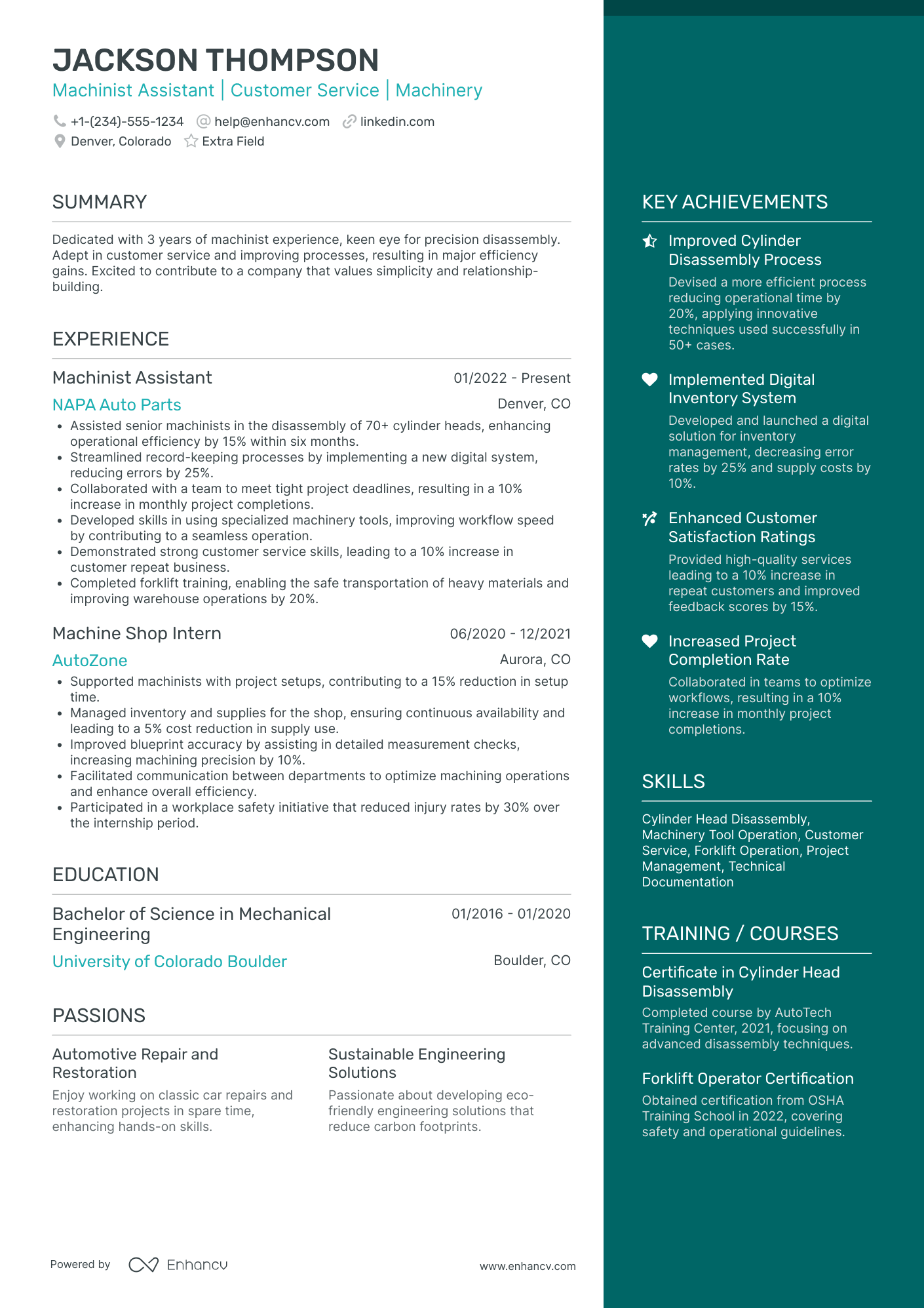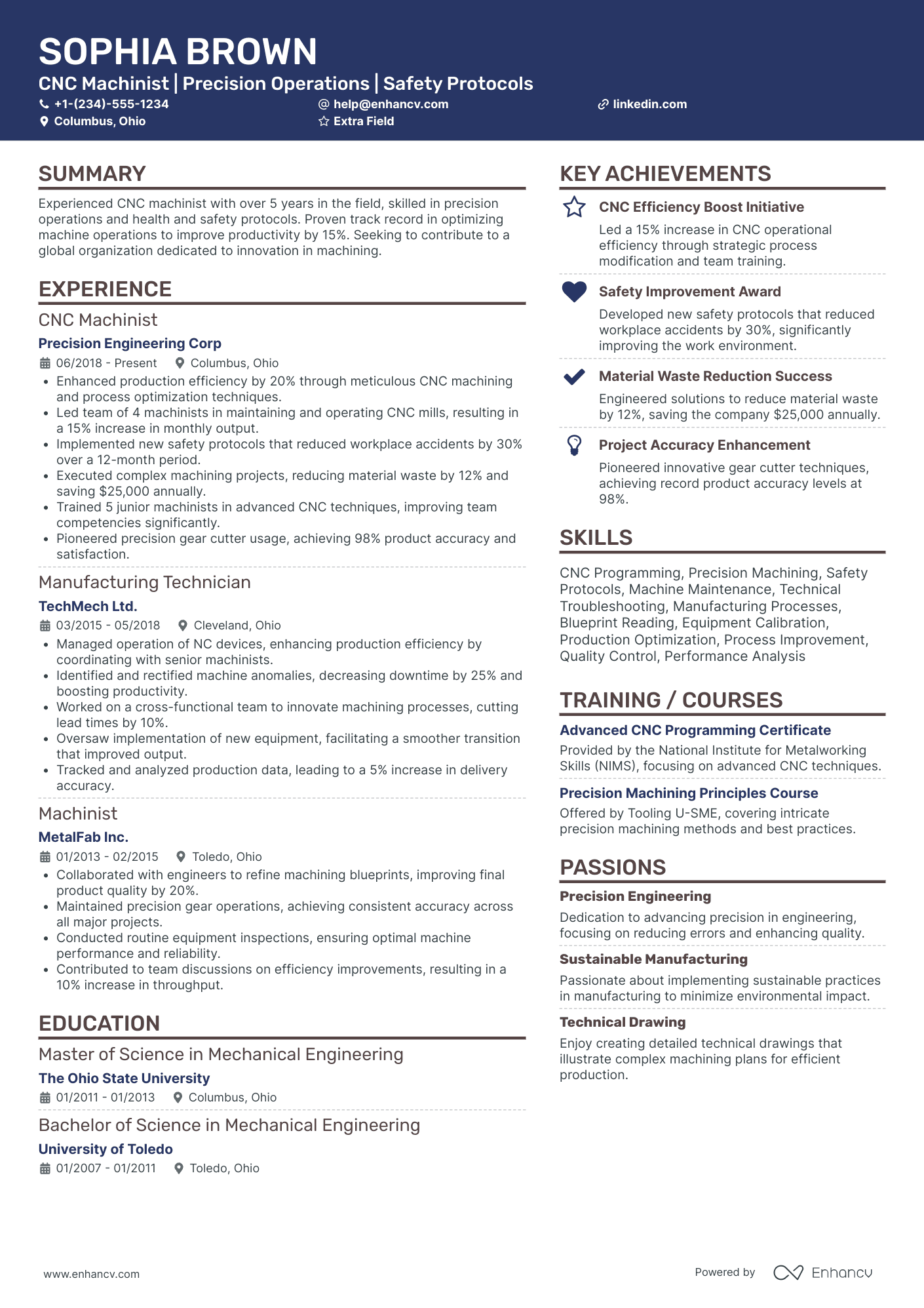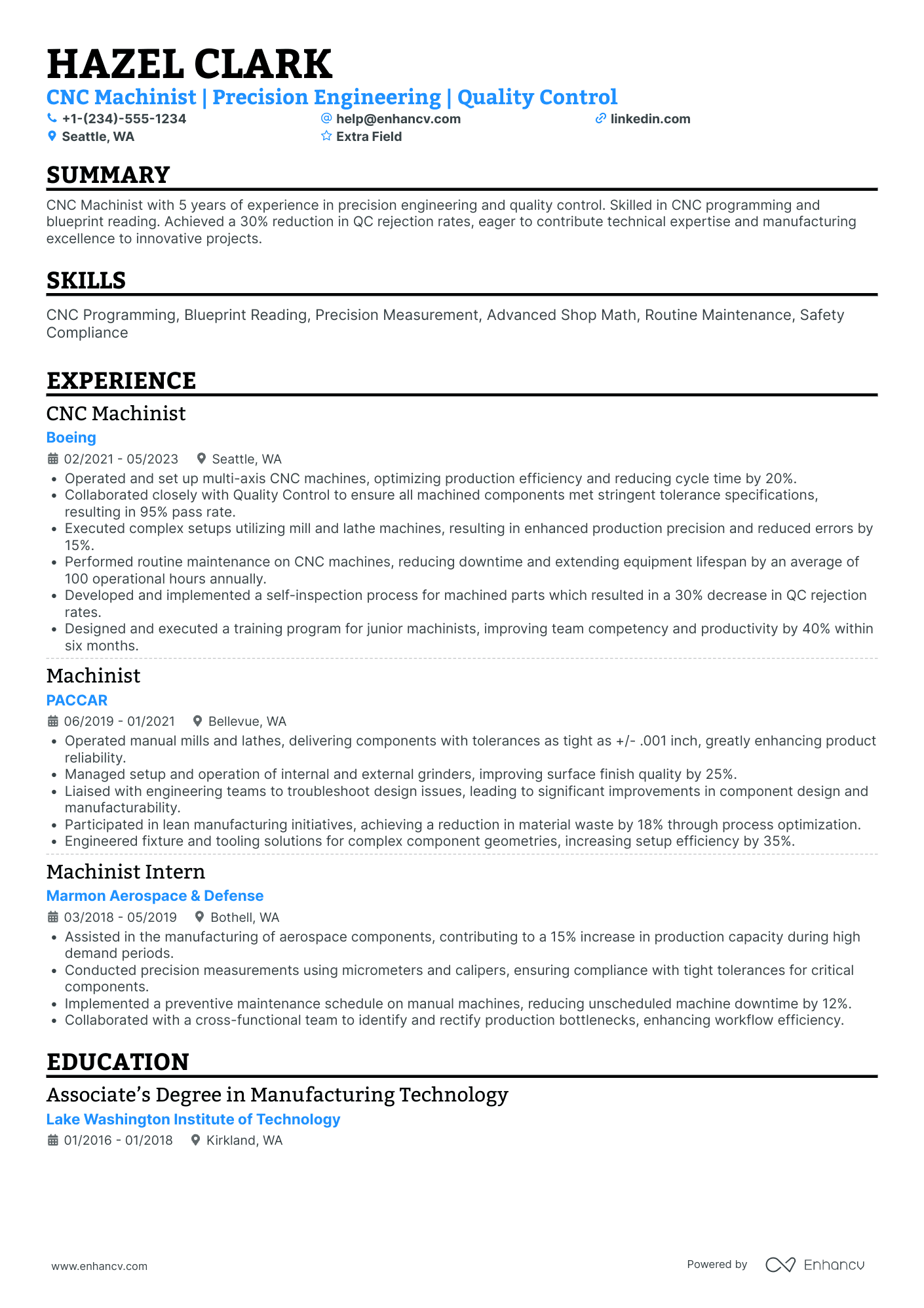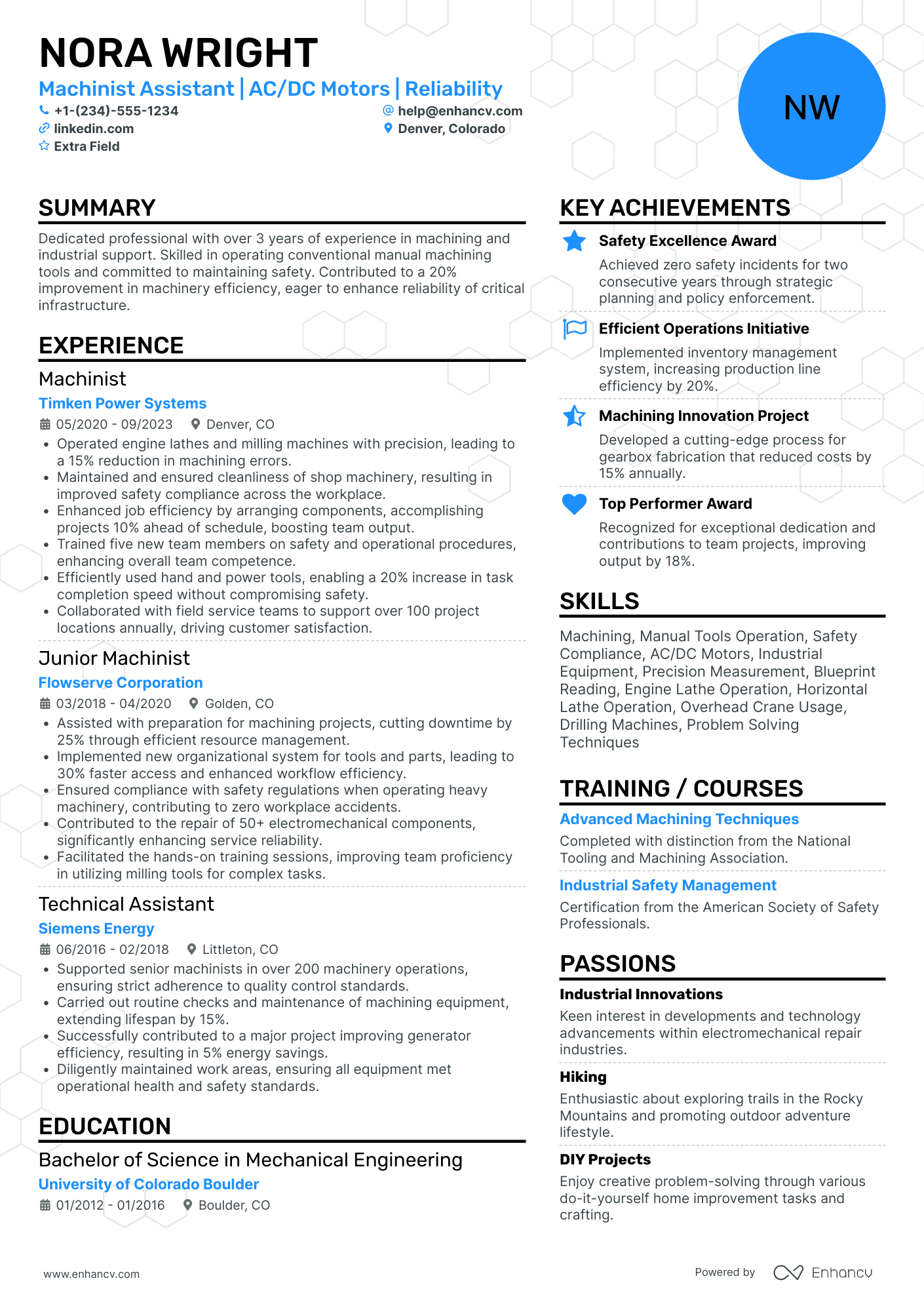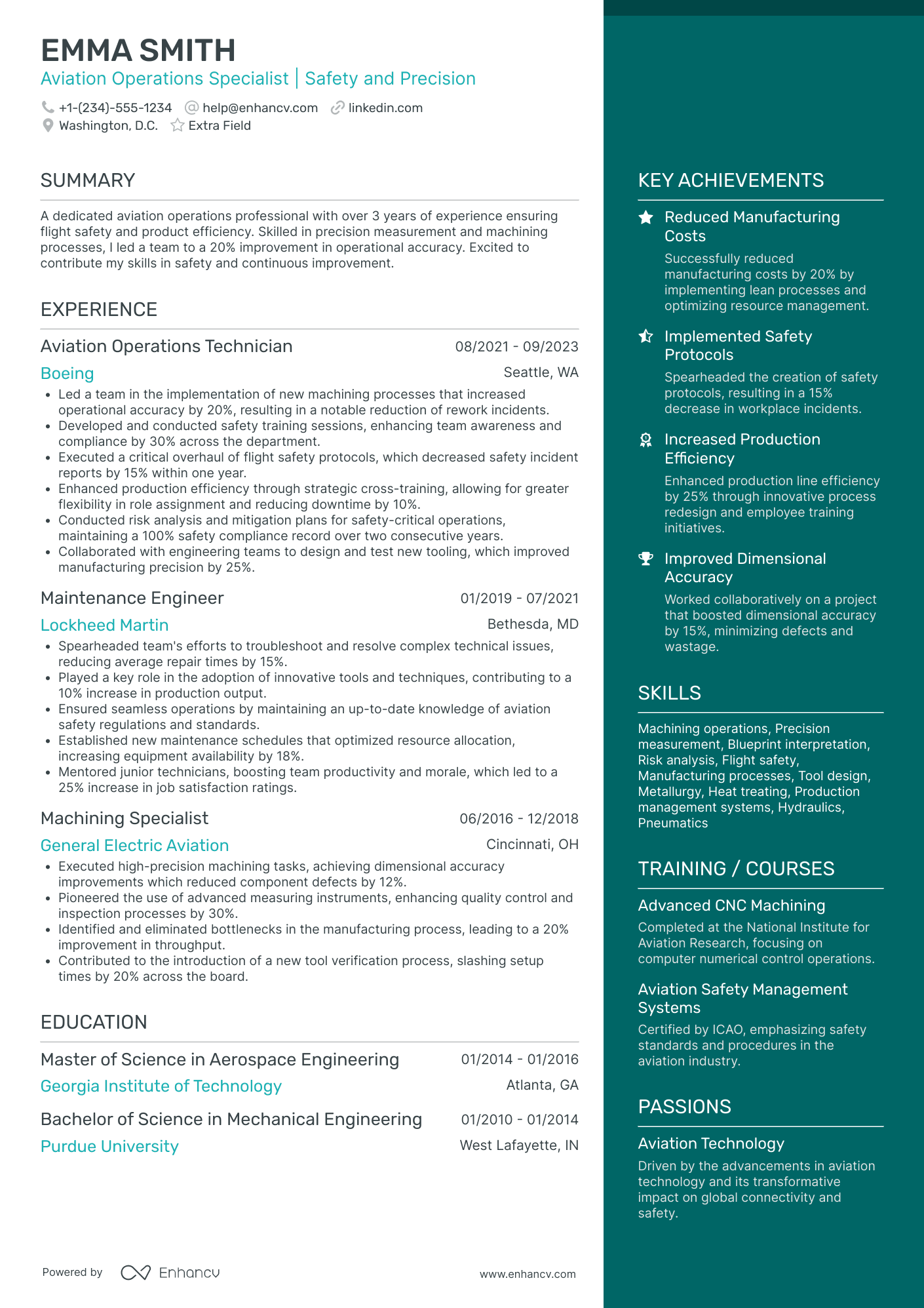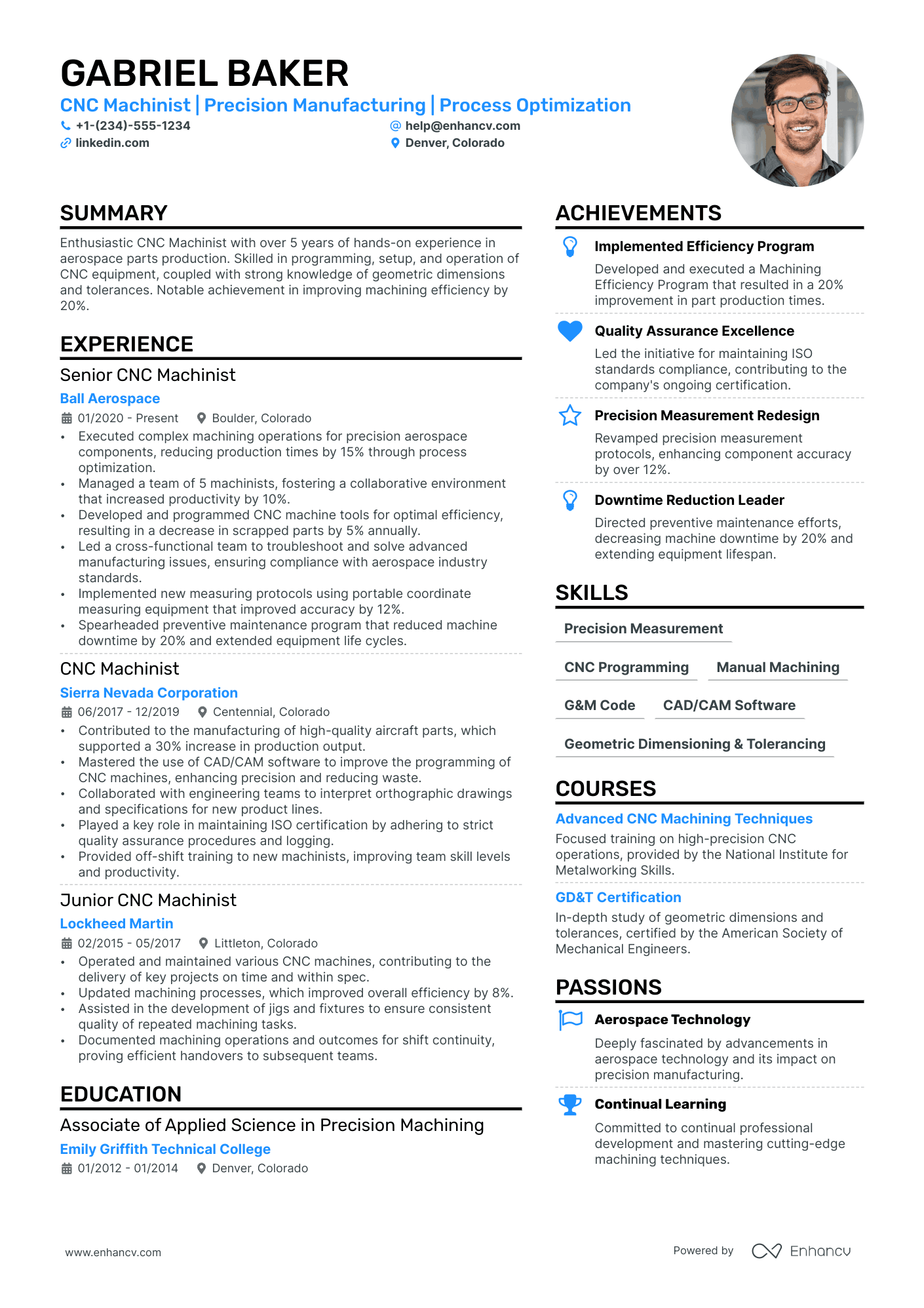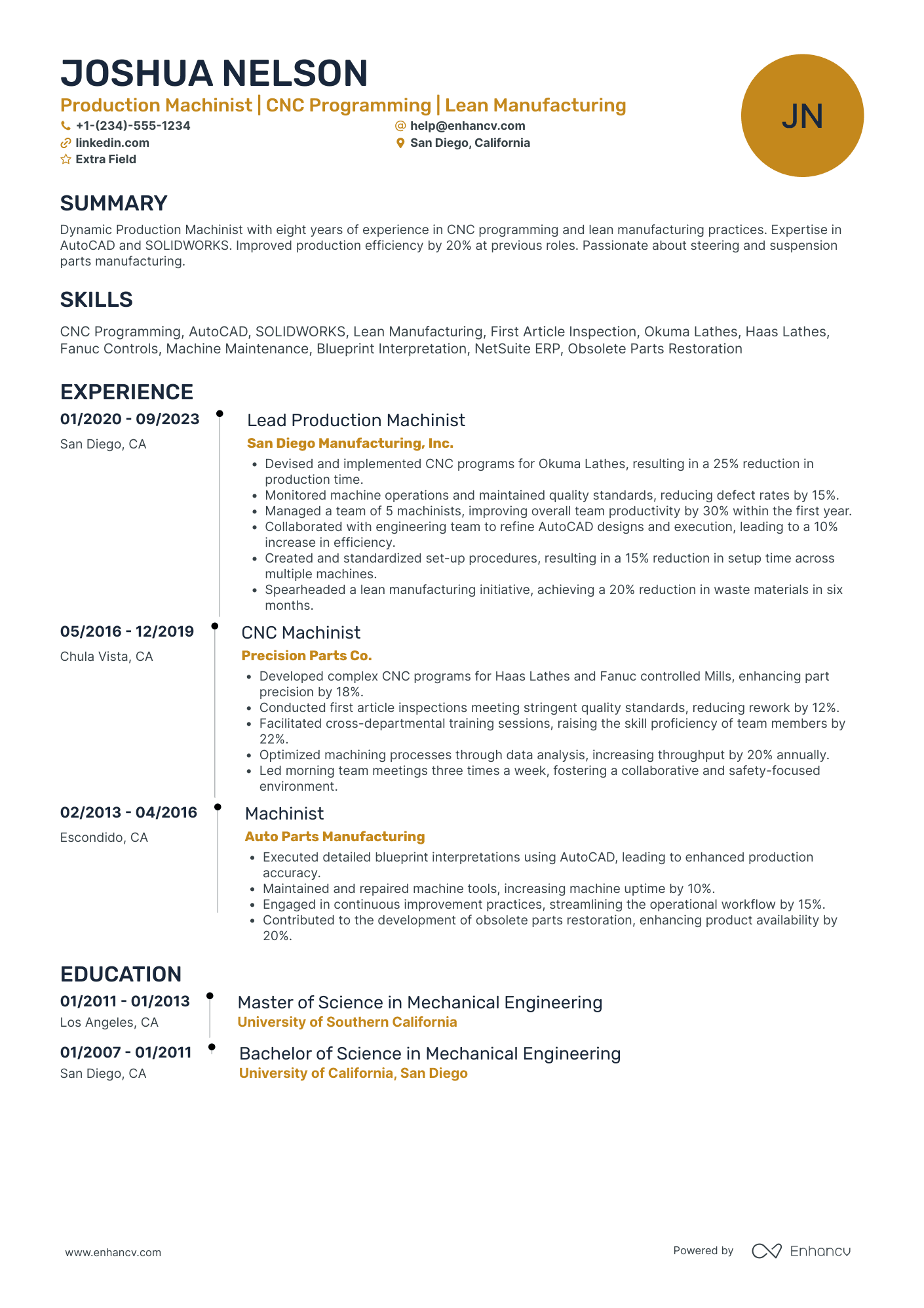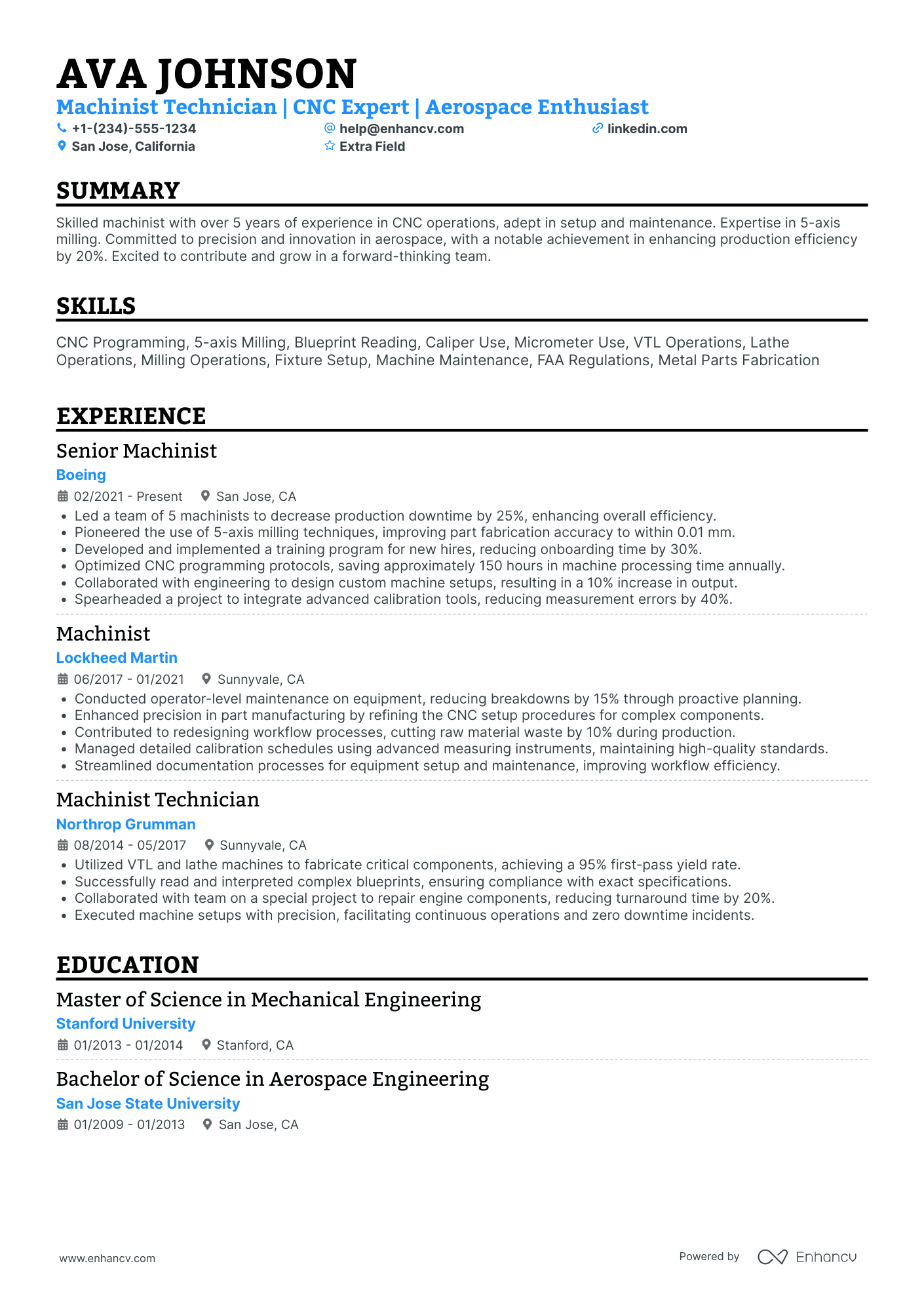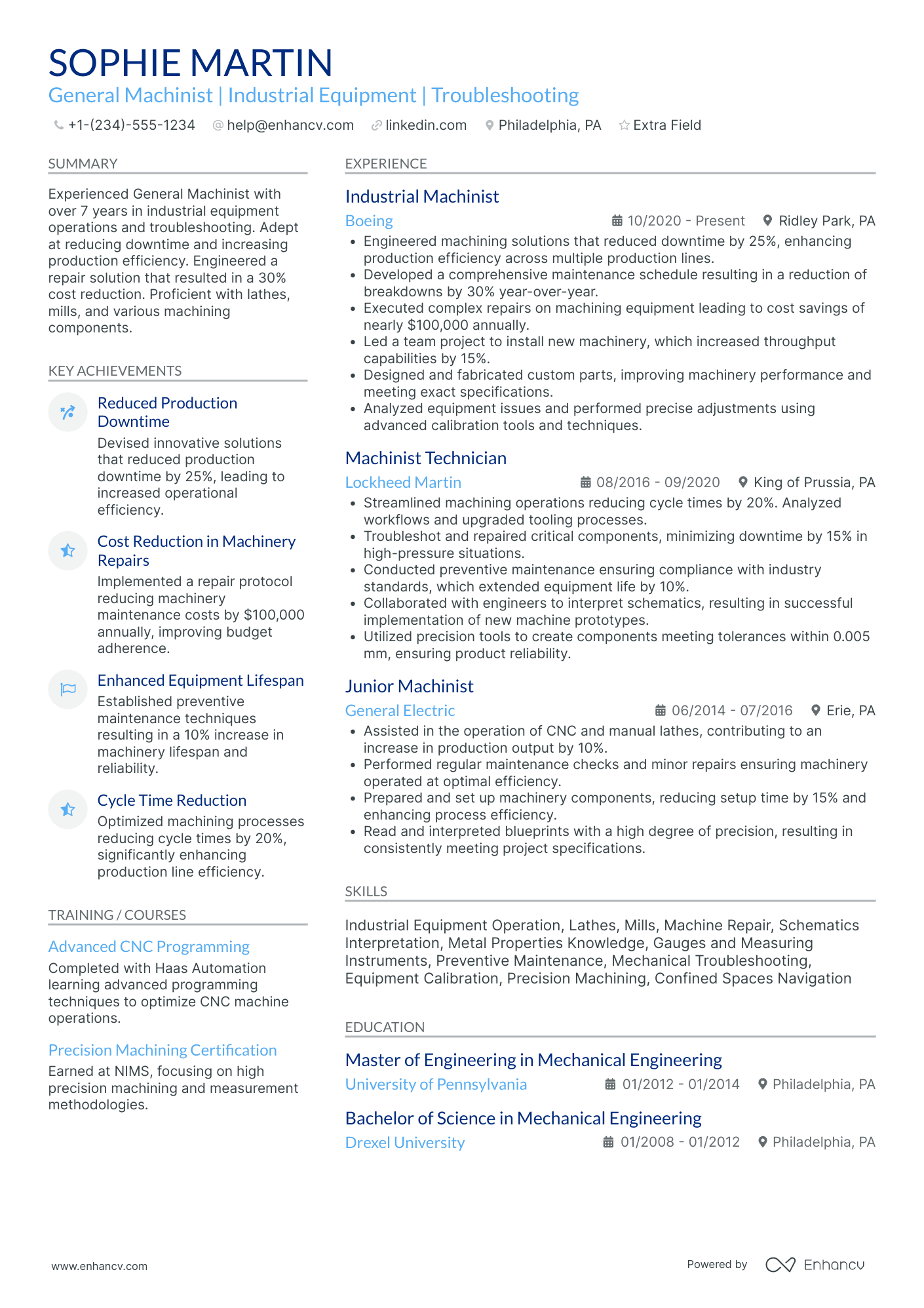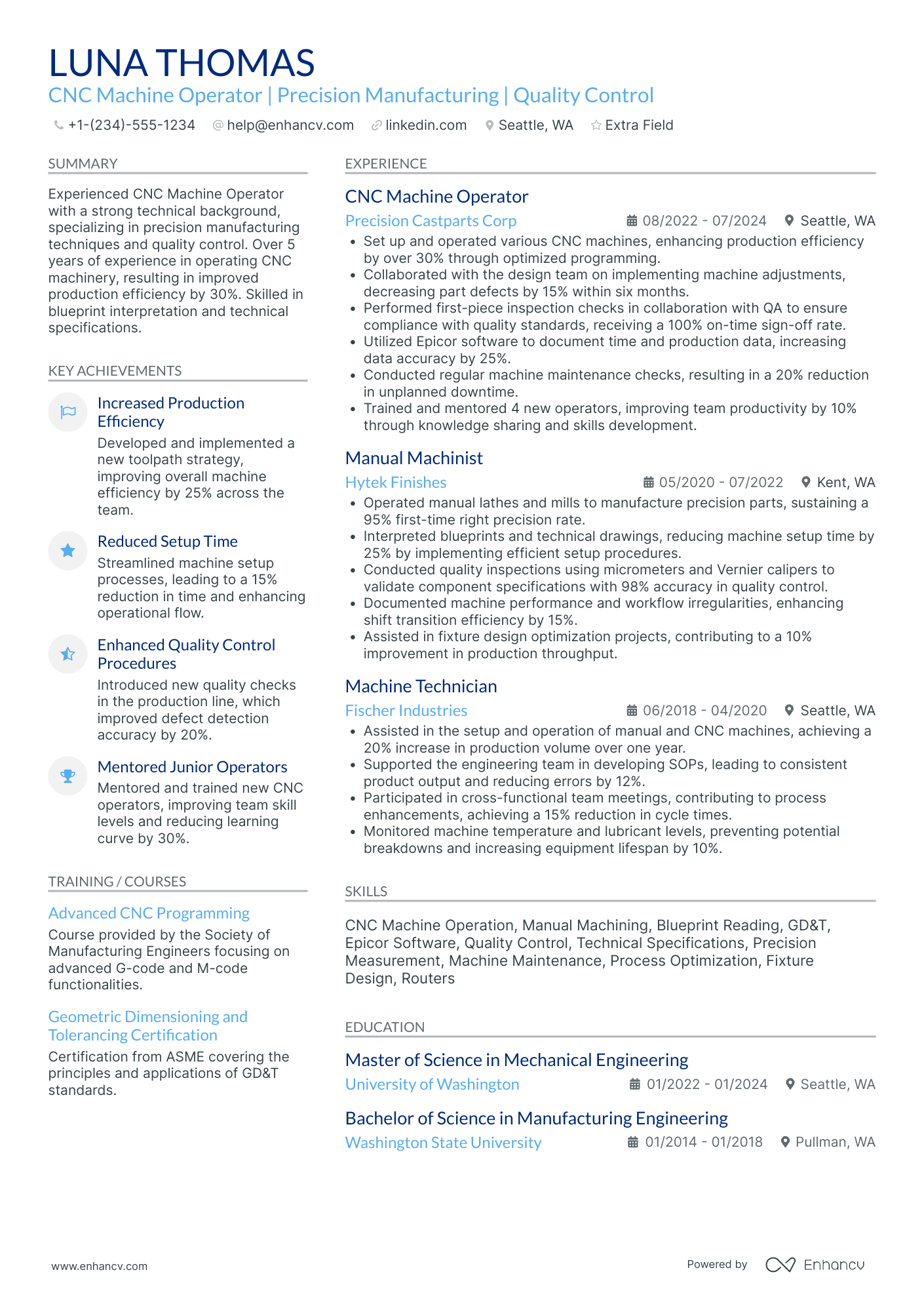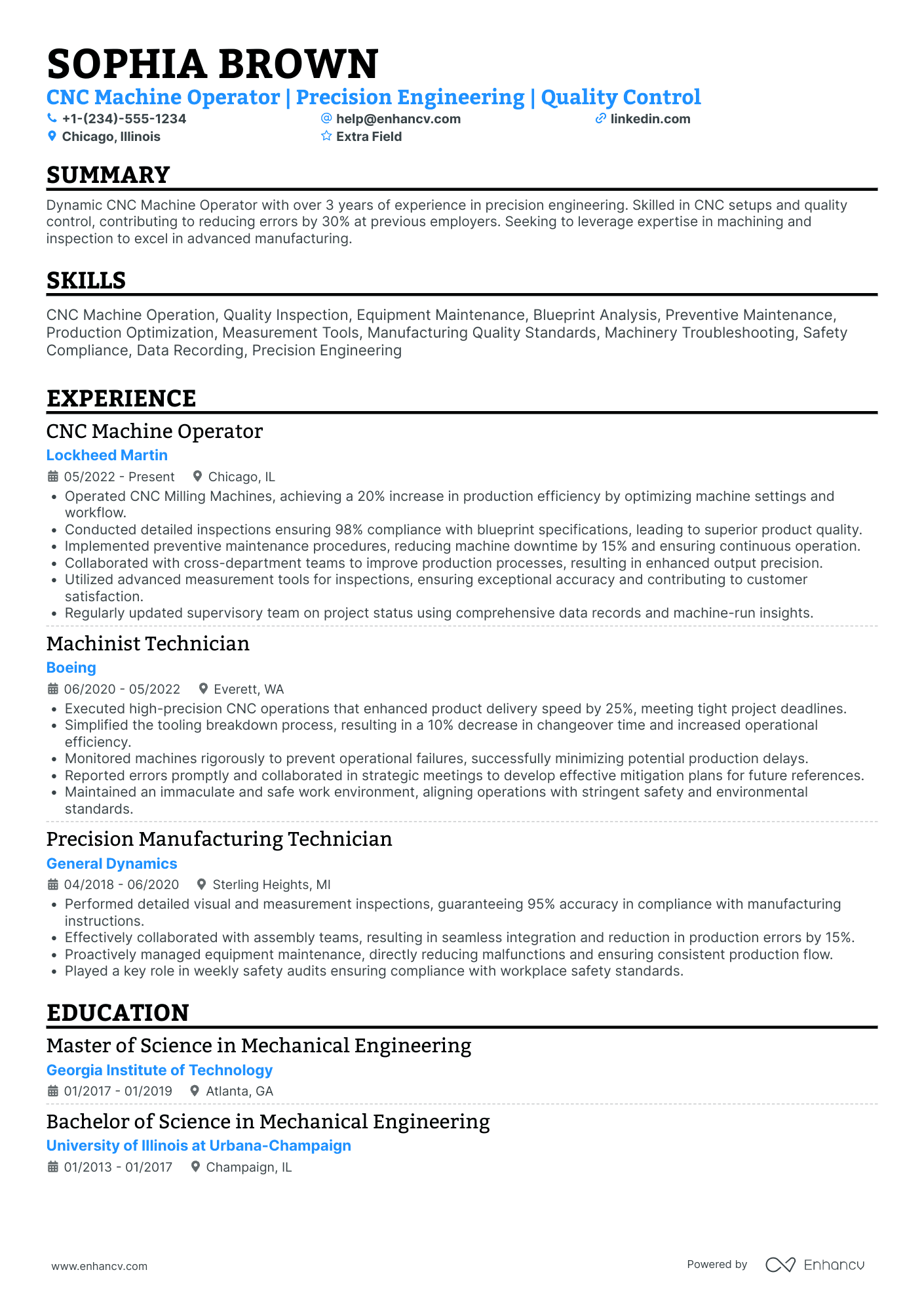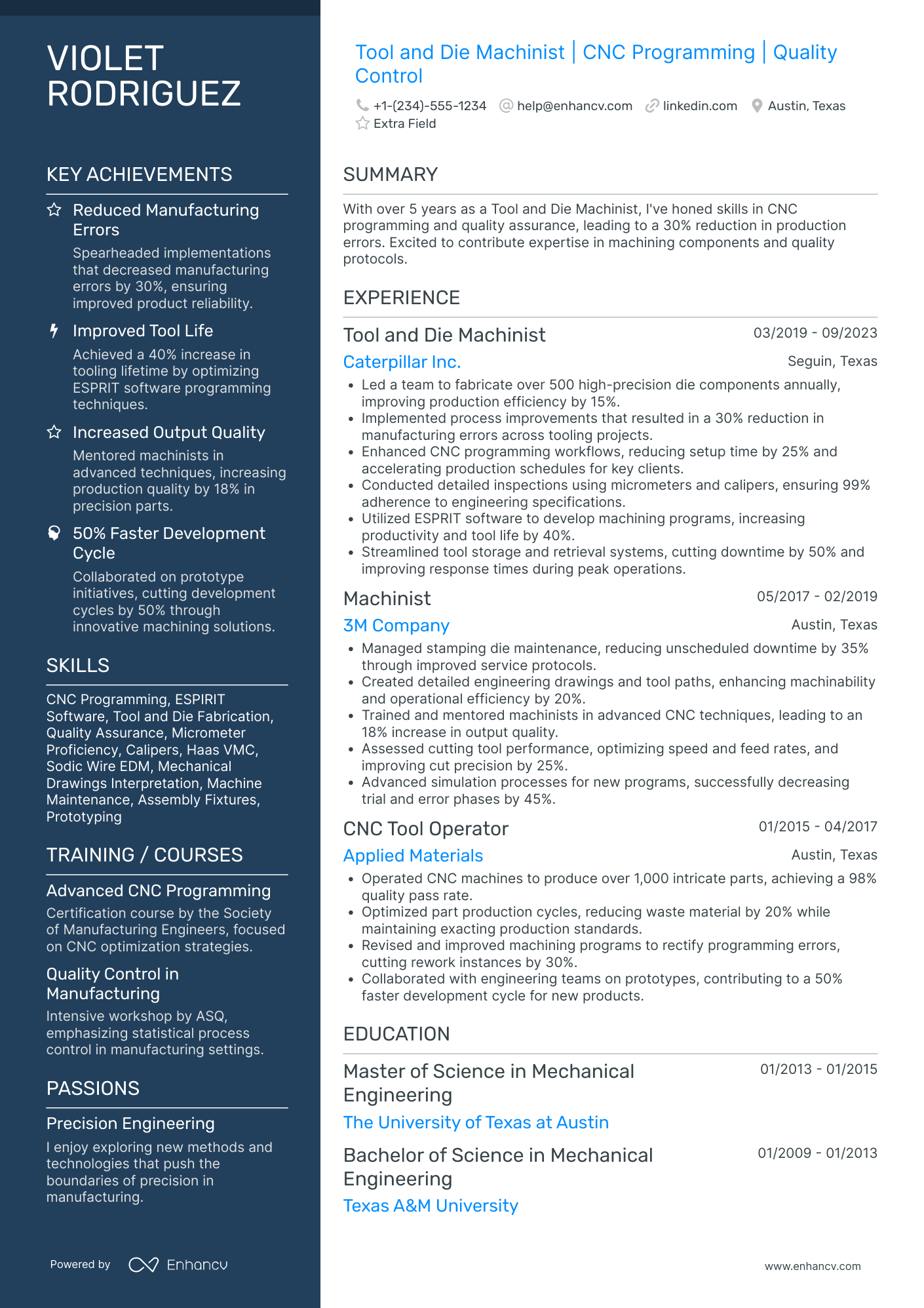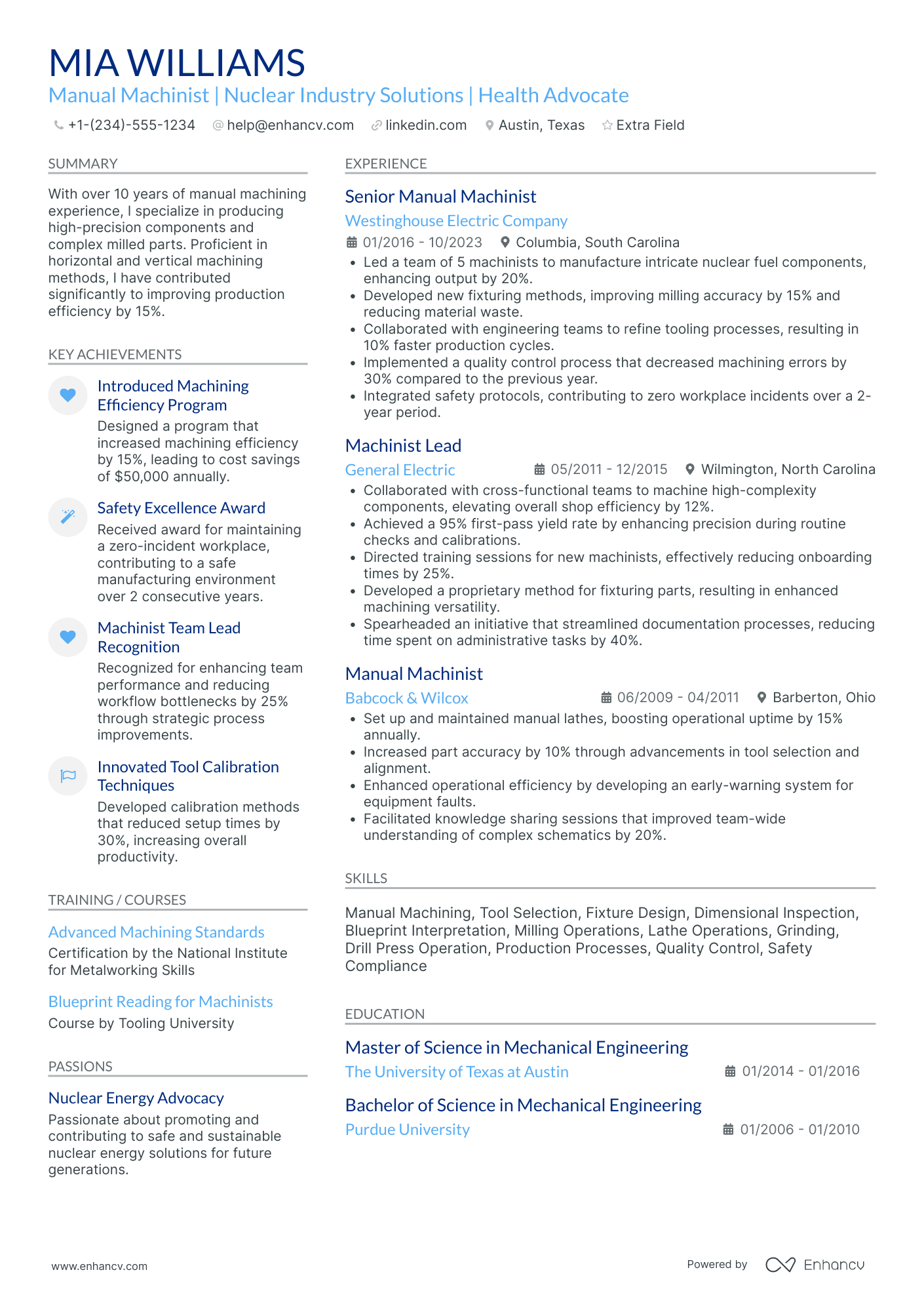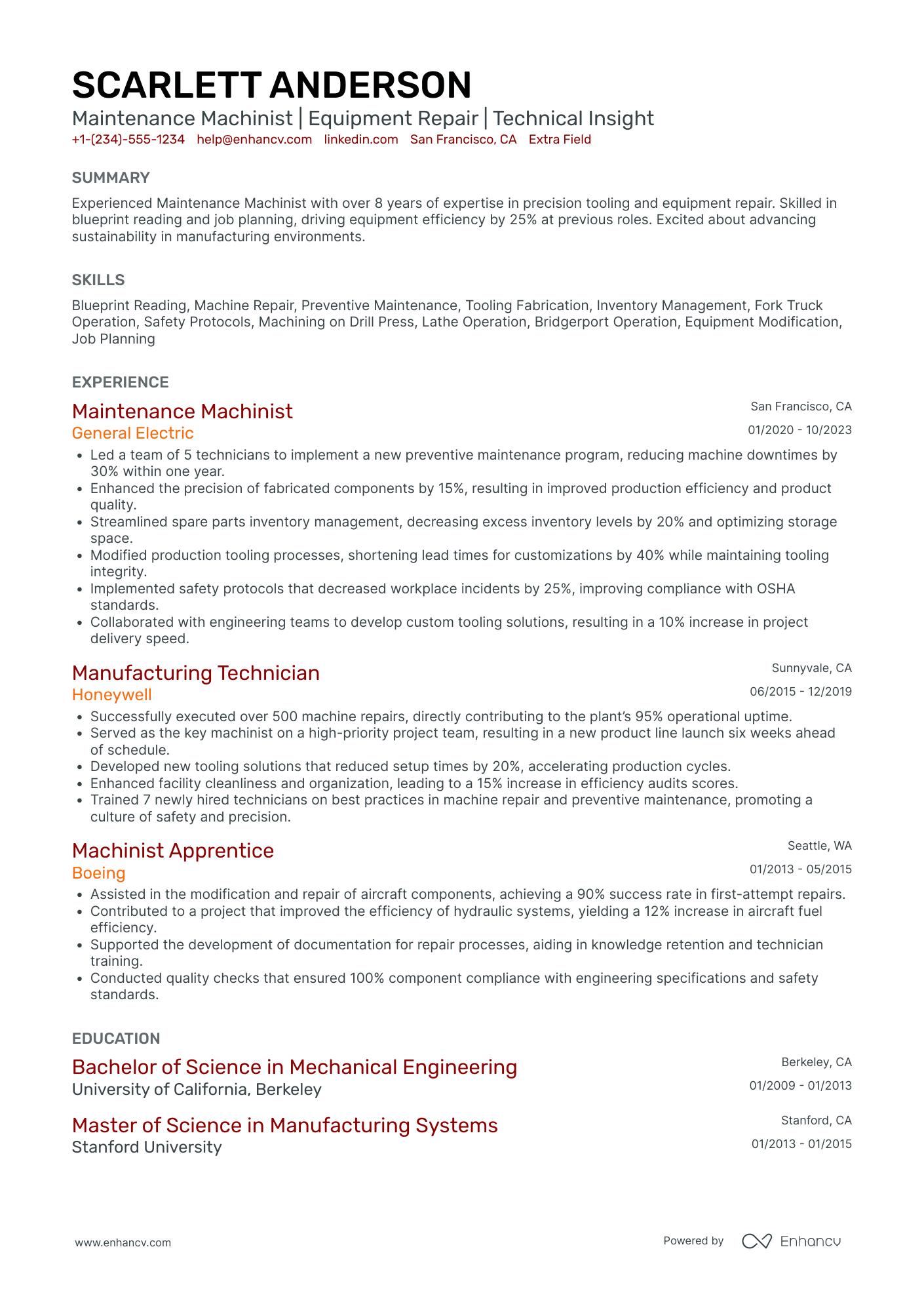As a machinist, one common resume challenge you might encounter is effectively showcasing your technical skills and precision workmanship to potential employers who may not be familiar with the specific machinery you've operated. Our guide can provide you with industry-specific tips to translate your hands-on experience into clear, impactful language that resonates with hiring managers, ensuring your expertise is both understood and valued.
- The most straightforward and effective resume format, ensuring your machinist resume stands out among numerous candidate profiles;
- The significance of the top one-third of your resume, including the header, summary or objective, and skills section, and its impact on recruiters;
- Frameworks and structures used by real machinist professionals, offering insights on how to enhance your resume with industry-specific expertise;
- A variety of machinist resume sections that bolster your profile, showcasing your comprehensive capabilities and distinctiveness.
Gaining insights from the best has never been easier. Explore more machinist resume examples below:
Machinist resume format made simple
You don't need to go over the top when it comes to creativity in your machinist resume format .
What recruiters care about more is the legibility of your machinist resume, alongside the relevancy of your application to the role.
That's why we're presenting you with four simple steps that could help your professional presentation check all the right boxes:
- The reverse-chronological resume format is the one for you, if you happen to have plenty of relevant (and recent) professional experience you'd like to showcase. This format follows a pretty succinct logic and puts the focus on your experience.
- Keep your header simple with your contact details; a headline that details the role you're applying for or your current job; and a link to your portfolio.
- Ensure your resume reaches an up-to-two-page limit, only if you happen to be applying for a more senior role or you have over a decade of relevant experience.
- Save your machinist resume as a PDF to retain its structure and presentation.
Tailor your resume format to the job market – a Canadian resume, for example, might differ in layout.
Upload & Check Your Resume
Drop your resume here or choose a file. PDF & DOCX only. Max 2MB file size.
PRO TIP
If the certificate you've obtained is especially vital for the industry or company, include it as part of your name within the resume headline.
The five (plus) definite sections your resume for a machinist job should include are:
- Header with your headline, contact details, and/or a preview of your work
- Summary (or objective) to pinpoint how your success aligns with the role
- Experience with bullets of your most relevant achievements in the field
- Skills to integrate vital job requirements (both technical and personal)
- Your further dedication to the field, showcased via relevant higher education and/or certifications
What recruiters want to see on your resume:
- Demonstrated ability to read and interpret mechanical documents and drawings
- Proficient in using a wide range of machinist tools and equipment, including CNC machines
- Experience with precision measuring instruments and electronic testing devices
- Knowledge of the properties of metal and other material
- Strong mathematical skills and understanding of machining procedures
Defining your professional expertise in your machinist resume work experience section
The work experience section, often the most detailed part of your resume, is where you discuss your past roles and achievements. To effectively list your experience, consider these four key tips:
- Align your expertise with the job requirements. It's vital to integrate keywords matching the job criteria to pass initial assessments;
- Show, don’t just tell. Quantify your responsibilities by stating your actual achievements in previous roles;
- Include measurable metrics. For instance, how did your performance impact the annual ROI?
- Highlight crucial industry skills. Mention both technological knowledge and interpersonal skills in this section.
These guidelines will help you craft an impressive machinist resume work experience section that is bound to catch recruiters' attention.
- Led a team of machinists in the manufacture of aerospace components, improving product quality by 15% over 2 years through meticulous process optimization.
- Developed innovative jigs and fixtures to expedite the machining process, which increased overall production speed by 25%.
- Designed and implemented a CNC program that reduced waste by 10% and improved material utilization, significantly cutting operational costs.
- Managed the fabrication of custom automotive parts, receiving a 95% customer satisfaction rating for precision and delivery time.
- Introduced a regular maintenance schedule for machining equipment, reducing downtime by 30% and extending machine lifespan.
- Collaborated with engineering teams to prototype parts for new car models, ensuring a 100% fit rate on initial installations.
- Enhanced the accuracy of machined components by performing detailed quality control, achieving a defect rate of less than 0.5%.
- Streamlined the production process by integrating Lean manufacturing principles, leading to a 20% increase in efficiency.
- Conducted training sessions on advanced machining techniques for junior machinists, raising team skills and productivity levels significantly.
- Operated multi-axis CNC machines to produce precision medical devices, while rigorously adhering to FDA guidelines for equipment and process validation.
- Implemented a tooling inventory management system that minimized production stoppages and contributed to a 10% increase in output.
- Collaborated with R&D to enhance product designs for manufacturability, shortening the prototype cycle by two weeks.
- Custom fabricated intricate components for experimental physics research, which required tolerances of up to +/- .0001 inches.
- Played a critical role in supporting the experimental team by providing rapid turnaround on complex, non-standard parts.
- Mastered the use of exotic materials such as Inconel and Titanium to meet highly specific research equipment needs.
- Established and oversaw a continuous improvement program for machining processes that resulted in a sustainable 15% increase in throughput.
- Successfully managed a cross-training initiative to ensure all machinists were proficient in both conventional and CNC machining operations.
- Won 'Best Innovation Award' for designing a proprietary part holding system that reduced setup times by an average of 20 minutes per operation.
- Directed operations within a high-volume machine shop, producing critical engine components with a zero-failure rate over the tenure.
- Implemented an advanced tracking system for project milestones, which improved on-time delivery by 40% for complex orders.
- Fostered a culture of safety and accountability, resulting in a record-breaking 500 consecutive days without a workplace accident.
- Expertly operated and maintained a fleet of high-precision Swiss-style lathes, contributing to a 12% increase in annual production volume.
- Key team member in the redesign of workflow layout, boosting shop efficiency by 35% by minimizing material handling and setup times.
- Took charge of apprenticeship programs, mentoring and training apprentices to become skilled CNC machinists, and reducing skill gaps within the workforce.
The following content includes information from "O*NET OnLine" by the U.S. Department of Labor, Employment and Training Administration (USDOL/ETA). Used under the CC BY 4.0 license. The data represents the top responsibilities present on the task lists for machinist professionals.
Top Responsibilities for Machinist:
- Dismantle machines and remove parts for repair, using hand tools, chain falls, jacks, cranes, or hoists.
- Reassemble machines after the completion of repair or maintenance work.
- Record production, repair, and machine maintenance information.
- Lubricate or apply adhesives or other materials to machines, machine parts, or other equipment according to specified procedures.
- Install, replace, or change machine parts and attachments, according to production specifications.
- Set up and operate machines, and adjust controls to regulate operations.
- Collaborate with other workers to repair or move machines, machine parts, or equipment.
- Read work orders and specifications to determine machines and equipment requiring repair or maintenance.
- Inspect or test damaged machine parts, and mark defective areas or advise supervisors of repair needs.
- Start machines and observe mechanical operation to determine efficiency and to detect problems.
Quantifying impact on your resume
- Include the number of complex components you have precision-machined to showcase your technical ability.
- Mention specific tolerances you've achieved in machining parts to demonstrate your attention to detail.
- Detail the percentage of scrap rate reduction achieved through process optimization to highlight efficiency improvements.
- Quantify the amount of time saved on projects by implementing new machining techniques to show your innovation.
- List the volume of materials you have experience with to illustrate your industry versatility.
- State the number of CNC programs you've written or modified to emphasize your programming skills.
- Document any cost savings realized through material selection or process changes to underscore your cost-effectiveness.
- Report the number of successful project completions to reflect your reliability and project management abilities.
Action verbs for your machinist resume
No relevant experience - what to feature instead
Suppose you're new to the job market or considering a switch in industry or niche. In such cases, it's common to have limited standard professional experience. However, this isn't a cause for concern. You can still craft an impressive machinist resume by emphasizing other sections, showing why you're a great fit for the role:
- Emphasize your educational background and extracurricular activities to demonstrate your industry knowledge;
- Replace the typical experience section with internships or temporary jobs where you've gained relevant skills and expertise;
- Highlight your unique skill set, encompassing both technological and personal abilities;
- Showcase transferable skills acquired throughout your life and work experiences so far.
Recommended reads:
PRO TIP
If you happen to have plenty of certificates, select the ones that are most applicable and sought-after across the industry. Organize them by relevance to the role you're applying for.
Bringing your machinist hard skills and soft skills to the forefront of recruiters' attention
Hard skills are used to define the technological (and software) capacities you have in the industry. Technical skills are easily defined via your certification and expertise.
Soft skills have more to do with your at-work personality and how you prosper within new environments. People skills can be obtained thanks to your whole life experience and are thus a bit more difficult to define.
Why do recruiters care about both types of skills?
Hard skills have more to do with job alignment and the time your new potential employers would have to invest in training you.
Soft skills hint at how well you'd adapt to your new environment, company culture, and task organization.
Fine-tune your resume to reflect on your skills capacities and talents:
- Avoid listing basic requirements (e.g. "Excel"), instead substitute with the specifics of the technology (e.g. "Excel Macros").
- Feature your workplace values and ethics as soft skills to hint at what matters most to you in a new environment.
- Build a separate skills section for your language capabilities, only if it makes sense to the role you're applying for.
- The best way to balance machinist hard and soft skills is by building a strengths or achievements section, where you define your outcomes via both types of skills.
There are plenty of skills that could make the cut on your resume.
That's why we've compiled for you some of the most wanted skills by recruiters, so make sure to include the technologies and soft skills that make the most sense to you (and the company you're applying for):
Top skills for your machinist resume:
CNC Machining
Manual Lathe Operation
Milling Machine Operation
Blueprint Reading
Precision Measurement Tools
Tool and Die Making
Welding Techniques
Metal Fabrication
CAD Software (e.g., SolidWorks, AutoCAD)
Maintenance of Machining Equipment
Attention to Detail
Problem Solving
Time Management
Communication
Teamwork
Adaptability
Critical Thinking
Manual Dexterity
Organization
Work Ethic
Next, you will find information on the top technologies for machinist professonals from "O*NET OnLine" by the U.S. Department of Labor, Employment and Training Administration (USDOL/ETA). Used under the CC BY 4.0 license.
Top technologies for Machinist’s resume:
- Management information systems MIS
- SAP software
- Microsoft PowerPoint
- Microsoft Excel
PRO TIP
Listing your relevant degrees or certificates on your machinist resume is a win-win situation. Not only does it hint at your technical capabilities in the industry, but an array of soft skills, like perseverance, adaptability, and motivation.
The importance of your certifications and education on your machinist resume
Pay attention to the resume education section . It can offer clues about your skills and experiences that align with the job.
- List only tertiary education details, including the institution and dates.
- Mention your expected graduation date if you're currently studying.
- Exclude degrees unrelated to the job or field.
- Describe your education if it allows you to highlight your achievements further.
Your professional qualifications: certificates and education play a crucial role in your machinist application. They showcase your dedication to gaining the best expertise and know-how in the field. Include any diplomas and certificates that are:
- Listed within the job requirements or could make your application stand out
- Niche to your industry and require plenty of effort to obtain
- Helping you prepare for professional growth with forward-facing know-how
- Relevant to the machinist job - make sure to include the name of the certificate, institution you've obtained it at, and dates
Both your certificates and education section need to add further value to your application. That's why we've dedicated this next list just for you - check out some of the most popular machinist certificates to include on your resume:
The top 5 certifications for your machinist resume:
- National Institute for Metalworking Skills Certification (NIMS)
- Precision Machining Technology Certificate (PMTC) - Various Trade Schools
- Computer Numerical Control (CNC) machinist Certificate - Various Trade Schools
- Mastercam Certification Program (MCP) - CNC Software, Inc.
- Certified Manufacturing Engineer (CMfgE) - Society of Manufacturing Engineers (SME)
The content below includes information from "O*NET OnLine" by the U.S. Department of Labor, Employment and Training Administration (USDOL/ETA). Used under the CC BY 4.0 license. The data represents the top associations for machinist professionals.
Top US associations for a Machinist professional
- American Welding Society
- International Association of Machinists and Aerospace Workers
- International Brotherhood of Boilermakers
- International Brotherhood of Teamsters
- International Union of Operating Engineers
PRO TIP
If the certificate you've obtained is especially vital for the industry or company, include it as part of your name within the resume headline.
Recommended reads:
The machinist resume summary or objective: integrating keywords, achievements, and more
Deciding whether to include a resume summary or an objective in your machinist resume is crucial. Both serve as key introductory elements at the top of your resume, encapsulating your profile in up to five sentences and incorporating relevant keywords from the job advert.
Here are the key differences between the two:
- The resume summary focuses on aligning your achievements and experience with the job requirements. It provides recruiters with a snapshot of your expertise, helping you stand out as an ideal candidate for the role.
- The resume objective, on the other hand, centers on your career goals and aspirations, detailing how the role aligns with your career progression. It's particularly suitable for candidates with less professional experience or those new to the job market.
Below are examples demonstrating best practices in utilizing the resume summary and/or objective to make a strong first impression with your machinist resume.
Resume summaries for a machinist job
- With over a decade of precision machining experience, adept in operating CNC machinery and complex lathe equipment, I have consistently delivered high-quality components within the aerospace industry. My crowning achievement includes reducing material waste by 15% through enhanced machining strategies at Globetech Aerospace.
- As an experienced machinist with 7 years of experience in the automotive manufacturing sector, I specialize in programming, setting up, and operating CNC machines to produce high-tolerance parts. Recently, I led a team project that achieved a 20% increase in production efficiency at Piston Automotive Solutions.
- Transitioning from a career in IT with robust problem-solving and analytical skills, I am eager to apply a methodical and detail-oriented approach to the field of precision machining. With comprehensive training in CAD/CAM software and a strong mechanical aptitude, I am well-prepared to contribute effectively to high-stakes projects.
- Seeking to bring a fresh perspective to machining from a background in material science, my unique understanding of metallurgical properties can enhance the development and fabrication of metal parts. I have hands-on experience with 3D printing and am proficient in SolidWorks, ready to apply these skills to traditional machinist tasks.
- Aspiring machinist with a strong foundation in mechanical engineering principles, I am enthusiastic about beginning my professional journey by mastering CNC programming and operations. My ultimate objective is to specialize in the creation of medical devices and to become a leading expert in the manufacturing of lifesaving technology.
- Eager to launch a career in machining with no prior experience but equipped with a fast learning curve and a commitment to quality craftsmanship. My objective is to acquire hands-on skills in operating advanced machinery and to ultimately contribute to groundbreaking innovations in the field of renewable energy components.
Optimize your resume summary and objective for ATS
Drop your resume here or choose a file.
PDF & DOCX only. Max 2MB file size.
Average salary info by state in the US for machinist professionals
Local salary info for Machinist.” Source: My Next Move, National Center for O*NET Development. Accessed 10/15/2024
| State | Average Salary (in USD) |
|---|---|
| US National Average | $57,350 |
| California (CA) | $62,190 |
| Texas (TX) | $52,150 |
| Florida (FL) | $55,500 |
| New York (NY) | $58,320 |
| Pennsylvania (PA) | $61,290 |
| Illinois (IL) | $50,440 |
| Ohio (OH) | $59,300 |
| Georgia (GA) | $51,020 |
| North Carolina (NC) | $51,390 |
| Michigan (MI) | $58,300 |
Extra sections to include in your machinist resume
What should you do if you happen to have some space left on your resume, and want to highlight other aspects of your profile that you deem are relevant to the role? Add to your machinist resume some of these personal and professional sections:
- Passions/Interests - to detail how you spend both your personal and professional time, invested in various hobbies;
- Awards - to present those niche accolades that make your experience unique;
- Publications - an excellent choice for professionals, who have just graduated from university or are used to a more academic setting;
- Volunteering - your footprint within your local (or national/international) community.
Key takeaways
- The format and layout of your machinist resume should reflect on both your career and what matters most to the job you're applying for;
- Use the resume summary and objective to hint at your most prominent accomplishments;
- Always be specific about your experience and consider what value each bullet you curate adds to your machinist application;
- Consider how your academic background and technical capabilities could further showcase your alignment to the role;
- Your soft skills should contribute to your overall machinist profile - aligning your personality with skills and results.
Machinist resume examples
By Experience
Machinist Assistant
Apprentice Machinist
Junior Machinist
Entry-Level Machinist
Machinist Trainee
By Role
